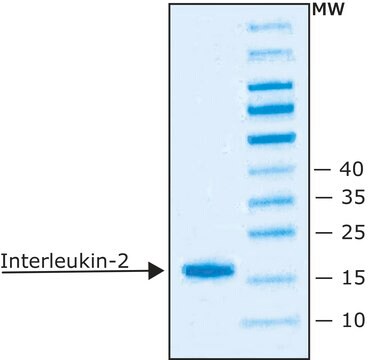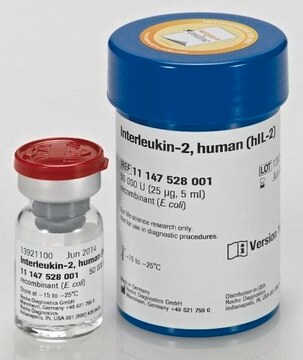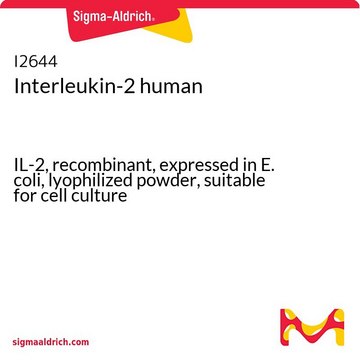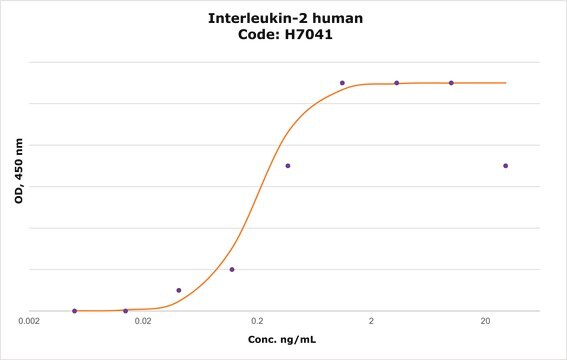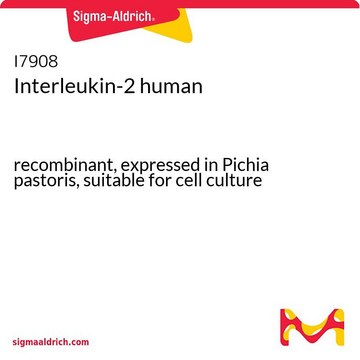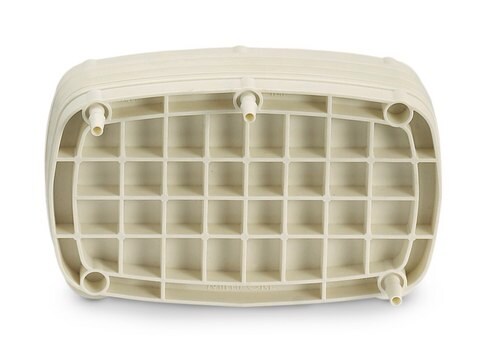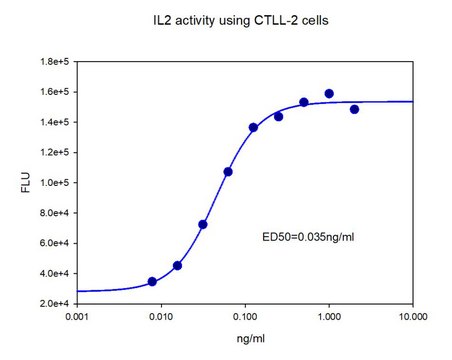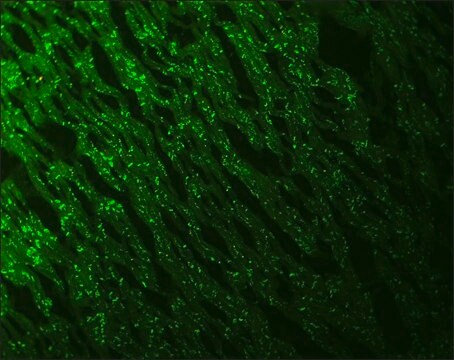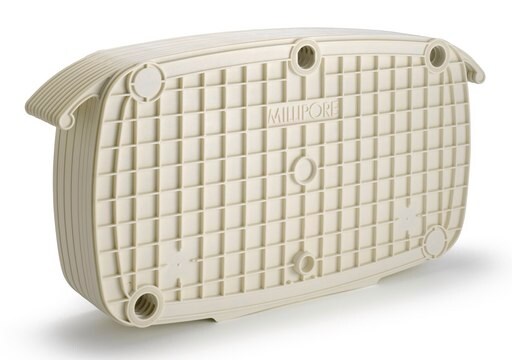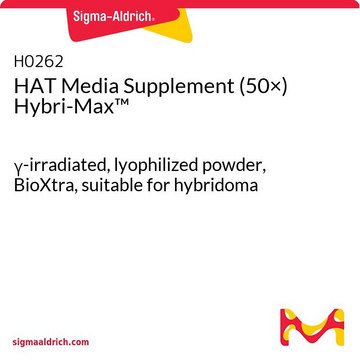11271164001
Roche
Interleukin-2, mouse (mIL-2)
recombinant (E. coli)
Synonym(s):
mIL-2, mouse interleukin-2
Sign Into View Organizational & Contract Pricing
All Photos(1)
About This Item
UNSPSC Code:
12352207
Recommended Products
biological source
mouse
Quality Level
recombinant
expressed in E. coli
Assay
>95% (SDS-PAGE)
form
solution
potency
<0.5 ng/mL EC50
mol wt
17,200 Da
packaging
pkg of 10,000 U (5 μg, 1 ml)
manufacturer/tradename
Roche
storage condition
avoid repeated freeze/thaw cycles
technique(s)
inhibition assay: suitable
impurities
<0.1 EU/μgtested (LAL test)
UniProt accession no.
storage temp.
−20°C
Gene Information
mouse ... Il2(16183)
General description
Contents: 10,000 U/ml solution in PBS and 1 mg/ml BSA, filtered through a 0.2 μm pore size membrane
Interleukin-2 (IL-2, also known as T-cell growth factor, TCGF) is a lymphokine produced by lectin- or antigen-activated T-cells. It plays an important immunoregulatory role. This factor was first identified by its ability to promote the long-term in vitro proliferation of activated T-cells. It also promotes the generation and proliferation of cytotoxic T-cells, natural killer (NK) cells, and lymphokine-activated killer (LAK) cells. IL-2 also induces other lymphokines such as interferon-γ and B-cell growth factor (BCGF-1).
Recombinant Interleukin-2, mouse (mIL-2), is produced in E. coli and purified by standard chromatographic methods.
Specificity
Mouse IL-2 is effective on mouse cells, but not on human cells.
Application
Recombinant murine IL-2 is produced in E. coli and exhibits the following:
- Supports the growth of murine CTLL cells (murine T cell line), but not that of human T-cells.
- Strongly inhibits the binding of recombinant human IL-2 to murine responder cells.
- Weakly inhibits the binding to human responder cells.
- Shares identical biological and immunological activities with human IL-2.
- Is a convenient tool for extensive studies of the pharmacological and physiological activities of IL-2 in murine models.
- used for the stimulation of murine T-cells
Quality
Endotoxin level: <0.1 EU/μg (LAL-test), <10 EU/ml (LAL-test)
Sequence
Chain Length 149 AA
One polypeptide chain (149 amino acids), identical to natural mouse IL-2, but not glycosylated. Glycosylation is not essential for biological activity.
Unit Definition
EC50 definition: The amount of mIL-2 that is required to support half-maximal stimulation of cell proliferation (XTT cleavage) with CTLL-2 cells (1 unit equals ≤0.5 ng).
Preparation Note
Working solution: Dilute the concentrated IL-2 solution (10,000 U/ml) with PBS or culture medium containing 1 mg/ml BSA [or HSA (human serum alburnin)], or 1 to 10% serum (v/v).
Storage conditions (working solution): -15 to -25 °C
Note: Avoid repeated freezing and thawing.
Storage conditions (working solution): -15 to -25 °C
Note: Avoid repeated freezing and thawing.
Other Notes
Specific activity/EC 50: >2 x 106 U/mg, <0.5 ng/ml (hIL-2, NIBSC, 1st international standard, 86/504), at least the same specific activity (EC50) compared to the indicated standard is guaranteed.
Note: The biological activity of this product may vary in different in vitro applications. Determine the optimal concentration range for specific applications.
EC 50 definition/Unit definition: The amount of mIL-2 that is required to support half-maximal stimulation of cell proliferation (XTT cleavage) with CTLL-2 cells (1 unit equals =0.5 ng).
Note: The biological activity of this product may vary in different in vitro applications. Determine the optimal concentration range for specific applications.
EC 50 definition/Unit definition: The amount of mIL-2 that is required to support half-maximal stimulation of cell proliferation (XTT cleavage) with CTLL-2 cells (1 unit equals =0.5 ng).
For life science research only. Not for use in diagnostic procedures.
Storage Class Code
12 - Non Combustible Liquids
WGK
nwg
Flash Point(F)
No data available
Flash Point(C)
No data available
Choose from one of the most recent versions:
Already Own This Product?
Find documentation for the products that you have recently purchased in the Document Library.
Customers Also Viewed
James Lee et al.
Methods in molecular biology (Clifton, N.J.), 506, 83-96 (2008-12-27)
In comparison to human T cells, efficient retroviral gene transfer and subsequent expansion of murine primary T cells is more difficult to achieve. Herein, we describe an optimized gene transfer protocol utilizing an ecotropic viral vector to transduce primary murine
Massimo Martinelli et al.
iScience, 26(1), 105860-105860 (2023-01-13)
The RNA-binding protein Pcbp2 is widely expressed in the innate and adaptive immune systems and is essential for mouse development. To determine whether Pcbp2 is required for CD4+ T cell development and function, we derived mice with conditional Pcbp2 deletion in
Anastasiia Kalinina et al.
STAR protocols, 2(1), 100368-100368 (2021-03-23)
Adoptive transfer therapy has great potential to treat diseases such as cancer as well as autoimmune and infectious diseases. Identification of chain-centric T cell receptors (TCRs) with the dominant-active antigen-specific α-chains (TCRα) can significantly improve the efficacy of adoptive cell therapy
Ping-Wei Zhao et al.
Mediators of inflammation, 2015, 762709-762709 (2015-04-22)
This study aimed to assess the differential expression of specific B cell subtypes in patients with chronic viral hepatitis. The frequencies of differential expression of specific B cell subtypes in patients with chronic viral hepatitis and healthy controls were assessed
Tae Joon Won et al.
Cellular signalling, 27(6), 1246-1252 (2015-03-13)
Small ubiquitin-like modifier (SUMO) 2 is a small protein that controls the activity and stability of other proteins by SUMOylation. In this study, T cell-specific SUMO2 overexpressing transgenic mice were generated to study the effect of SUMO2 on T lymphocytes.
Our team of scientists has experience in all areas of research including Life Science, Material Science, Chemical Synthesis, Chromatography, Analytical and many others.
Contact Technical Service